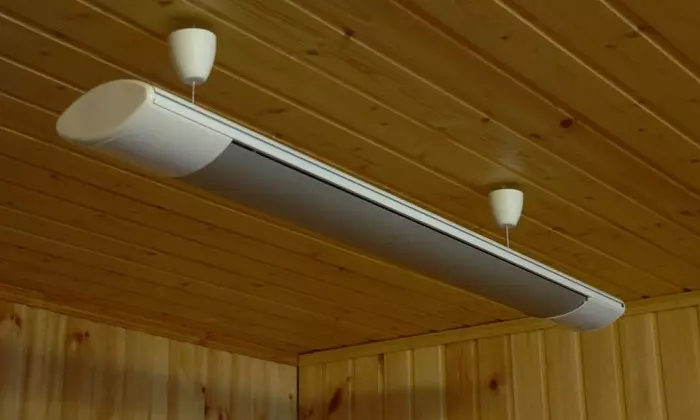
Ceiling heaters based on infrared radical differ differ from convectors, which, according to its action, are intended to warm air. Infrared waves have a big length: it is they who are perceived by us as a heat emanating from the sun's rays. It is warmed by such rays regardless of the presence of drafts or wind and infrared heaters, which are used in everyday life: because the radiation wavelength is similar to the wavelength of the infrared spectrum of the Sun.
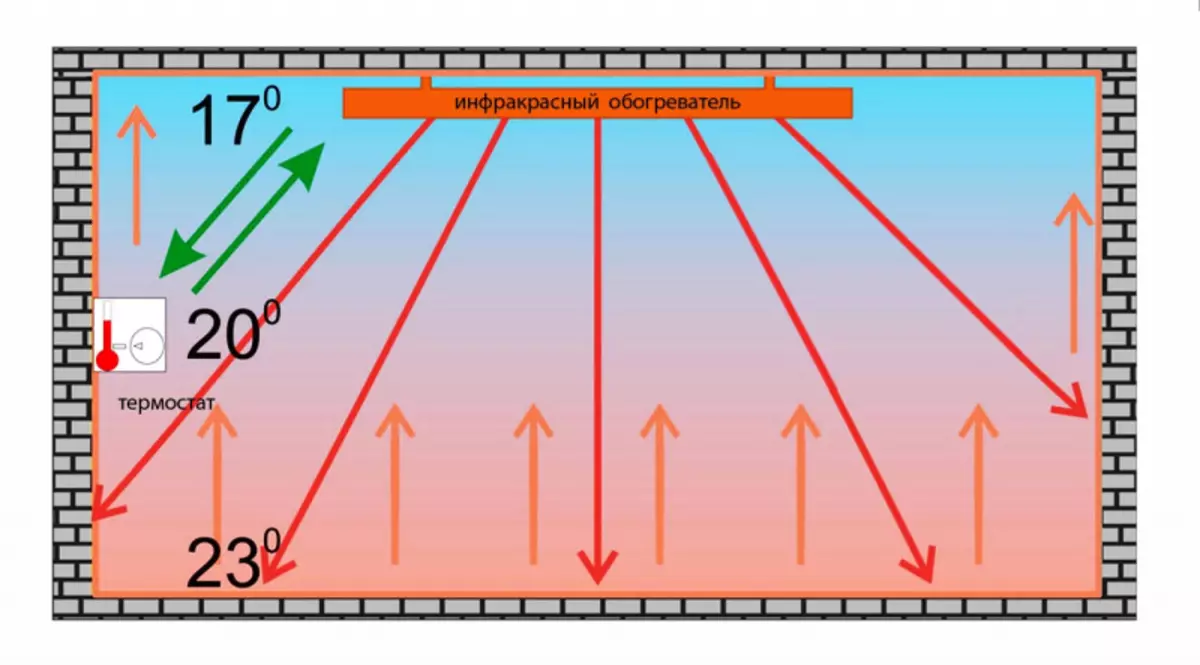
Scheme of heating room with infrared heater.
The convector cannot heat the room instantly, since during its work there is a movement of warm air upwards. First of all, the space is heated in the area of the ceiling - this is a significant disadvantage, which is deprived of infrared ceiling heaters. How to choose this heating system and not guess? We will try to understand below.
Structurally, the device does not have complex controls, in the steel case, to which the solid powder paint is applied, is an aluminum reflector. The reflector contains the main heating element. In the current market of heating systems, 4 varieties of these elements are presented: carbon, halogen, ceramic and tubular.
Each infrared heater is equipped with a thermostat for temperature control and a sensor that turns off the device when overheating.
Advantages of using infrared heaters
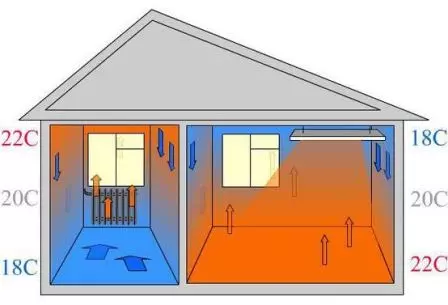
Heat distribution in a house with an infrared heater.
The main advantage of such structures lies in the fact that they do not dispel heat, and the action is sent to heating the necessary object. In contrast to the various heating elements, thermal radiation is not absorbed by air, the energy of the device reaches heated surfaces.
Justice It is worth saying that infrared heaters belong to the category of devices of a new generation, being an absolute alternative to the traditional electrical heater. Due to the fact that the design is attached to the ceiling, it can fit into any interior, do not break the harmony of design. Infrared ceiling heaters can be used by domestic owners, since the possibility of contacting the pet with the heating system is completely excluded.
As an element of heating, infrared ceiling systems are advantageously different from other parameters:

The infrared heater does not have a large number of parts, so there is almost nothing to break in it.
- High heat supply speed - heat transfer by the device begins after 27 seconds after switching on;
- silent work;
- Infrared heating systems are practically no oxygen;
- Significant savings - according to specialists, the cost of heating the premises decrease by 40%;
- lack of air circulation, which allows them to install them on the street;
- Spot and zonal heating - warming specific sections of the room;
- the absence of excretion of harmful odors, which, in turn, reduces the likelihood of poisoning to zero;
- Environmental environmentally friendly heating;
- A number of studies make it possible to approve the favorable effects of infrared radiation on the body;
- Installation mobility - on a telescopic rack, on the wall, on the ceiling;
- Ease of mounting the ceiling device.
Infrared heaters have a number of quality indicators, however, have a disadvantage: due to intensively light radiation, certain inconveniences are delivered when used at night.
Principle of operation of infrared heaters
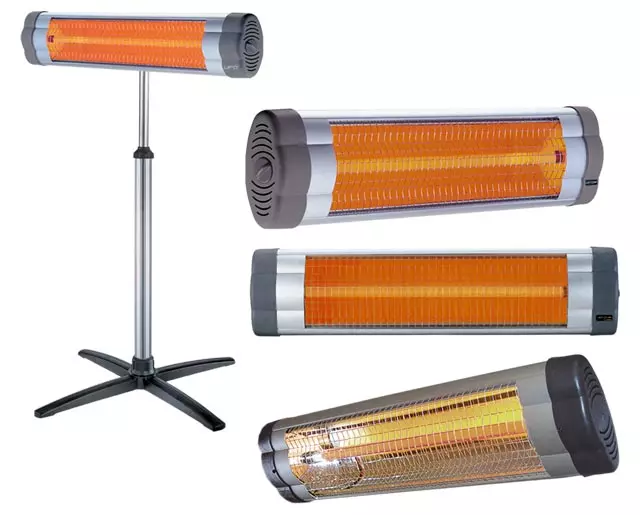
Infrared heaters do not dry the air indoors.
The principle of operation of this type of heaters is based on the heating of air indoors, but on the heating of items located there and the human body, after which the items transmit heat to the air. Due to this, moisturizes and the composition of the air do not change, and the amount of oxygen remains stable. Plates can be heated from 100 ° C to 950 ° C. The calculation of the heating intensity is carried out individually for each room, taking into account the size of the room, the height of the ceilings and a number of other parameters. For example, for the room with a standard ceiling height2.5-3.5 m, it is possible to effectively use the heating of the surface 100-120 ° C. In case the ceiling above 3.5 m is allowed to heat up to 950 ° C. Despite the fact that we are talking about extremely high temperatures, infrared radiation of instruments, which is used for heating is absolutely safe, which is confirmed by multiple studies of both manufacturers themselves and independent experiments.
Article on the topic: Selection and rules for installing loops with a door closer
Manufacturers at the moment are offered quite extensive equipment selection: ceiling infrared heaters for home, for industrial premises, for wet rooms and even heaters for explosive areas.
Wave Length and Heating Temperature

The required number of infrared heaters for the main types of premises.
Heating elements located inside infrared heaters have different radiated waves and different heating temperatures. They are as follows:
Emitters, which emit long waves (within 5.6-100 microns), have a operating temperature from 100 ° C to 600 ° C, can be used in homes, in offices, in industrial premises with ceilings height not more than 3 m.
The average waves (from 2.5 to 5.6 microns) emit heating elements having a temperature in the range from 600 ° C to 1000 ° C. When using them, the ceiling of the room should have a height of 3-6 m.
Short waves (from 0.74 to 2.5 microns) are emitted by heating elements operating at a temperature of 100 ° C. For their efficient operation, the ceiling height is required in 6-8 m. Most often, they find their use in factory or factory workshops, on the street.
Types of infrared heaters with ceiling mount
In order to choose a heater, it is necessary to take into account a number of factors affecting its performance and a general classification based on the features of the design, installation and control. Depending on the heat source, heaters may relate to categories of gas, electrical or electric film.Gas infrared heaters in most cases are designed for use in industrial premises or on the street, since they have a rather impressive power. It works such a system with a gas mixture. The enclosure is perforated plates, on the surface of which this mixture is burned.
The main part of electrical infrared heaters is a tubular electric heater or an open spiral. In addition, the design provides a reflector reflecting infrared radiation in the direction of the room. The instruments of this category found their widespread use in both industrial and residential premises.
Film infrared heaters are used in residential areas in order to heat specific local areas. The main details of these heaters are carbon elements.
Classification of the Ceiling heaters based on the appointment
For appointment, heaters can be household and industrial. Household infrared heating systems most often refer to the category of electrical heaters. Such a choice is due to a small capacity of instruments, operation of operation, aesthetic appearance, and in some cases even the possibility of introducing a designer solution.
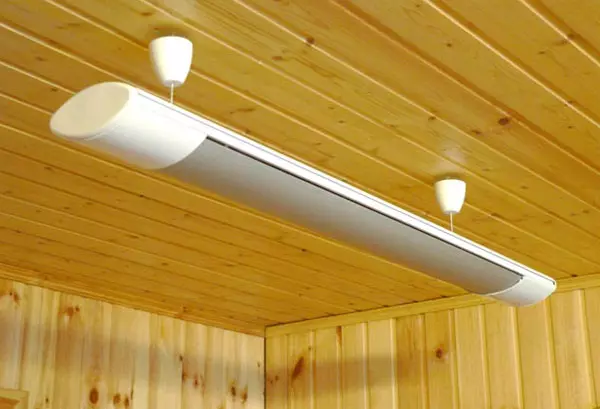
Ceiling heaters can be used for any types of rooms, while they do not occupy useful space.
Such ceiling structures for heating will certainly be estimated by the owners of apartments and houses with a large number of plants that require stable comfortable conditions for growth. Heaters can be mounted where there is a glazed loggia or balcony, as it will be a faithful assistant in the fight against Founding.
Thanks to its safety, they can be installed in children's rooms. In contrast to convective type heaters, infrared structures will not exacerbate the position and do not contribute to the circulation of dust.
In an industrial scale, heaters use significant power indicators and large dimensions. They are installed, as a rule, on special pillars or under the ceiling. The power of such structures allows to heat the warehouse, garages, hangars, public institutions, industrial premises, offices, sports facilities, winter gardens, wellness complexes, sanatoriums, hospitals, greenhouses.
Article on the topic: Self-adhesive film used for kitchen
Heating public institutions with the help of conventional heating devices is practically impossible due to the large patency, while infrared heaters perfectly perform this function. In addition, these devices can significantly save space due to the installation carried out under the ceiling.
Also in the production premises, due to the extensive area of premises and ventilation, heating convective type is impossible, only infrared. The reason for this lies in the ability of infrared heaters to heat the directly working area, objects and people who are.
Classification by the type of heating element
Choosing one or another infrared heater for household needs, it is worth considering that one of the main differences is the shell in which the element emitting the waves is located.

The halogen heating element can adversely affect the person.
The halogen heating element is nothing more than a halogen lamp, the radiation of which passes in the infrared band. Inside the lamp placed the grinding thread from tungsten or carbon fiber. In the process of heating the thread, infrared energy is distinguished and the lamp tube is transmitted. Halogen lamps emit golden light, which has a negative effect on the eyes, irritating them. To maximize negative impact, manufacturers cover lamps with a special composition. However, the main disadvantage of this heating element lies in the fact that the element is emitted short waves that have a negative impact on humans.
Carbon heater The element is a quartz tube. Inside the vacuum is created in which the carbon spiral is located. The advantages of this type of elements are quick heating and efficiency exceeding the efficiency of the heated metal plate. Do not forget about the main disadvantage - a short operational period, they serve about 2 years. They light them with a reddish light capable of annoying eyes. Refuse such heating elements is to people suffering from asthma and allergies.
The heating element with a ceramic shell has a high level of protection, so it does not shine during operation. The service life of such an element reaches no less than 3 years, together with the cost-effectiveness it is financially attractive way of heating the room. The range of power consumed is 50-2000 W, which is caused by structural features. Despite the fact that elements cannot quickly warm up and cool, they are often used in medical institutions, saunas, as they have high strength indicators.
The tubular metal element has the maximum similarity with the ceramic system. They are reliable and convenient to everyday life, however, in the process of work, a specific crackling can be mastered, the cause of which is the various coefficients of temperature expansion of the aluminum hull and steel spiral.
Determining the required power
Before choosing a household heater, it is necessary to understand a number of features of its future exploitation: whether it will be the only or additional source of heating, room area, the required power, the design features of the ceiling.
The determination of the required power of the heater is performed on the basis of the formula: 100 W per 1 m² of area. However, such calculations can be used only to premises that are well insulated and do not have large-scale heat sources, in the case of using an infrared heater as the main source of heat. If we are talking about the "dogrev" of the room, you can use less power per unit area.

So that in the room it is cozy, you need to choose the power of the infrared heater.
To the resulting number of power data, manufacturers recommend adding another 10% of a small stock. It is necessary to take into account other factors, otherwise, with insufficient power, there may be situations of the inefficient use of the heater or the electricity overrun during excess capacity.
In order not to become a hostage of this situation, it is recommended to follow a number of tips:
- With ceiling height of more than 3.5 m and area up to 100 m², the selection of ceiling household heaters is practically not limited, but nuances appear during installation.
- When the ceiling height is up to 3.5 m and the area of about 100 m², it is recommended to mount several infrared heaters.
- With the height of the ceilings less than 3.5 m, it is not recommended to use ceiling infrared industrial heaters even when heating a warehouse or garage.
- With ceiling height of less than 2.5 m and an area of residential room to 50 m², prefer the heater model with no capacity indicators of no more than 700 W.
Article on the topic: Ecopol - Gypsum Bulk Paul
The required power is determined by the height of the ceilings: the lower the ceiling, the less power must have heaters. This recommendation is based on considerations of a comfortable stay of a person under the device. The smaller the power indicators, the less the intensity of the radiation, the softer the radiated heat. For the room in 20 m² and the height of the ceiling 2.2 m, it is enough to install 4 600 W 50 heater. While for the room of a similar area with a ceiling height of 4 m, one power heater is required in the range from 2.2 to 2.6 kW.
To properly choose a heating ceiling system, it is worth paying attention not only to the power of the heater, but also the minimum, and the maximum height of the suspension. These characteristics will help correctly adjust the height of the heater mounting during installation.
Selection of shape and material
The most popular form that household heaters possess is a flat rectangular long panel. Manufacturers of infrared ceiling heating systems offer structures specially created to install in suspended ceilings "Armstrong". They, like the ceiling sections, have a square form with a side of 60 cm, so that the installation is carried out in the cell in the section. These devices due to low power are used in low ceilings as an additional heating.The heat-insulating elements of infrared ceiling heaters are made of various materials. In most cases, this is a metal plate. The most optimal option is to use aluminum plates, the best solution is anodized aluminum. This type of plates radiates more heat and is distinguished by durability.
Many manufacturers have replenished their model range of devices with a ceramic heat-insulating plate, it is considered a little more efficient, because Ceramics has the best radiating ability, compared with the metal.
However, the most perfect material in this context is glass. Modern technologies make it possible to produce household heaters in which the glass performs the role of a heating and heat-existing element. Glass heats itself. A distinctive feature of such devices is their durability, because in the design there is nothing to break and come into wear.
Basic errors when choosing infrared heaters
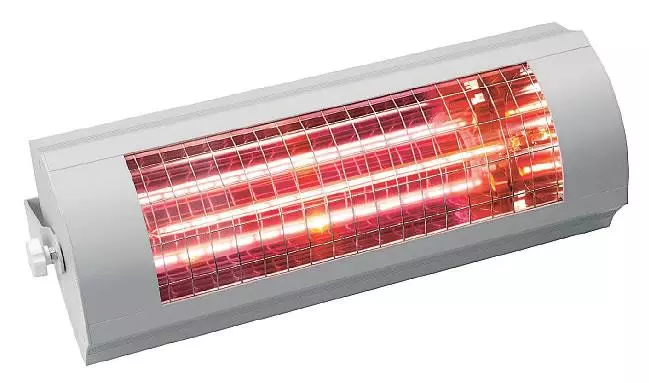
It is not worth buying too powerful infrared heater for small rooms, since condensate may appear due to overheating.
- Frequently cases when movable by desire to save buyers acquire more powerful heaters, putting forward the area of the room in the chapter choice. The uneven distribution of infrared rays is the cause of overheating of some points of the room, resulting in humidity in the corners and colder zones.
- For the garage, ceiling infrared heaters should choose, oriented not to the power supply, but for additional protection.
- If we are talking about the selection of the heating system for cluttered dark room furniture, it is worth navigating only on the characteristics for the purpose of point heating, since the uniform heating of the room will be difficult.
- The optimal radiation angle for ceiling heaters is not 90 °, but 120 °.
Relying on the criteria, it is worth paying attention to a certain specificity of heaters. To date, manufacturers offer many models for children's rooms equipped with a high level of electrical safety, for industrial premises with a high level of dustproof, for baths with random splash protection and high moisture resistance class.
The correct approach to the selection of heaters is a guarantee of obtaining comfortable conditions and a long period of their operation.
